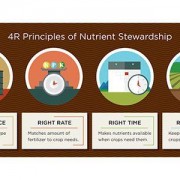Easy, Efficient, Effective, or Expensive?
Let’s get it right out of the way first: I am not an agronomist.
I do, however, have a solid base of understanding relating to agronomy. With tongue in cheek I like to say, “I know enough to be dangerous.” Nonetheless, I took great pride in the significant attention to detail I employed while being in charge of seeding when still part of the farm. I carefully measured TKW (thousand kernel weight) and calculated seed rates accordingly. I was diligent about what fertilizer, and volume of fertilizer went into the seed row (we only had a single shoot drill.) I always slowed down to 4mph or less when seeding canola and ensured to reduce the wind speed to the lowest possible rate to minimize the risk of canola seed coat damage.
I always had a long season in spring from having to cover the whole farm twice: once with a fertilizer blend to be banded, (all of the N and whatever PKS that couldn’t go in the seed row) usually at least 2″ deep; the second pass was with seed and an appropriate PKS blend that could be be in the seed row. It’s just what I did to respect what I’d learned about the importance of fertilizer rate and placement. It took more time in applying, hauling home, storing, etc. It created operational challenges during application (it seems there were never enough trucks and augers available.) It took more time to set the drill for the correct application rate. All of that didn’t matter to me because I only had once chance to get the crop in the ground and fertilizer properly applied (at least at that time, the equipment we had made it so that all fert was applied in spring) and I wasn’t going to leave anything to chance that I could easily control.
The key point in fertilizer management is “The 4 R’s.” Right source, right rate, right place, and right time of fertilizer application make for the best use of your investment. So why over the last number of years have we seen such a boom in spreading fertilizer on top of the soil?
This article was recently published by FCC. There is no ambiguity as to the best and most effective way to apply phosphorus. I’ll ask again, “What’s with the shortcuts?”
I know the answer: time. There isn’t time to incorporate adequate volumes of fertilizer into the soil. We can use a spinner that has a 100′ spread at 10mph (or more;) this permits more fertilizer to be applied in a shorter amount of time, and it permits fewer stops to fill the drill during seeding…all of it saving precious time. I get it.
But where is the trade off? Have The 4 R’s of Fertility been tossed aside completely? Where is the balance?
Casting aside the proven science of the 4 R’s in order to save time by broadcasting is easy and efficient, but is it effective? I suppose that depends on what effectiveness you are trying to accomplish. I’m suggesting effectiveness of the fertilizer you’ve paid dearly for.
Direct Questions
When making important management decisions like fertility, what methods are you employing to determine your best strategy?
Where is your balance between ease, efficiency, effectiveness, and expense when making critical management decisions?
How has your Unit Cost of Production projection changed if you decide to accept only 80-90% effectiveness from your fertility program?
From the Home Quarter
What is easy might seem efficient, we might believe it is effective, but it is most likely expensive. Historically, decisions were made with the goal of minimizing expense with little else given to consider ease, efficiency, or effectiveness. Management decisions that do not provide adequate emphasis on effectiveness will likely see higher expenses. Your focus with your agronomy must be to produce at the lowest Unit Cost of Production possible on your farm. Choosing a fertilizer application method that places more emphasis on that which is easy versus that which is most effective is likely to create a situation that is expensive. Management decisions that focus heavily on one aspect to the detriment of the others rarely achieve results that meet or exceed expectations.
Introducing the Growing Farm Profits 4E Management System™. Details to follow.




